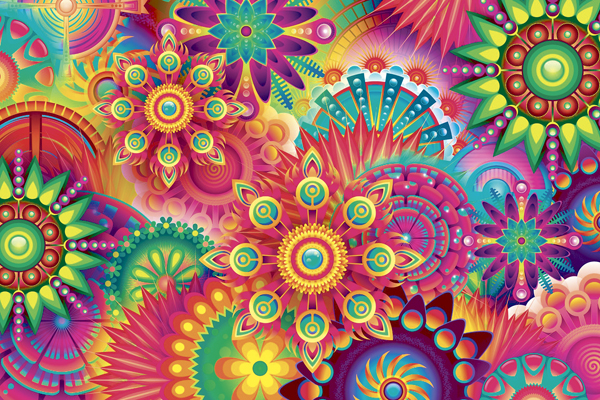Researching psychedelics
Making the case for hallucinogens as a viable medical option
October 11, 2017
“Psychedelic” is a word used to describe mind-altering and sometimes bizarre hallucinations, especially as it relates to hallucinogens. A hallucinogen is any psychoactive chemical that changes perception, thoughts, emotions and consciousness.
The word “hallucination” comes from the Latin word “alucinari” which means “to wander in one’s mind.” LSD, psilocybin mushrooms, salvia, MDMA, DMT (ayahuasca), mescaline, PCP DXM and a handful of other substances are all classified as hallucinogens. These powerful chemicals have a long history of being consumed for religious purposes and used medicinally across cultures.
However, many of these substances are illegal across much of the world. In the United States, hallucinogens are categorized as Schedule 1 and 2 drugs, with no potential for medicinal use, and a high potential for abuse. In the ’60s and ’70s there was some research being done on LSD, but Presidents Richard Nixon and Ronald Reagan ramped up funding for narcotics task forces, otherwise known as the “War on Drugs.”
Research on hallucinogens abruptly stopped as it became nearly impossible to acquire the chemicals in a lab. Nowadays, psychedelic drug research is gaining some mainstream media attention, particularly MDMA-assisted therapy for those with PTSD and the Amazonian brew known as ayahuasca.
As a member of the Psychedelic Club at UND, I want to be the best vessel of information I can be for students who are addicted or curious. It is important to keep in mind that these are powerful chemicals with the potential for very negative, potentially life-threatening consequences, so I am in no way condoning the use of these chemicals. But for those who choose to use, I want to be someone they feel comfortable going to stay safe and informed.
The Psychedelic Club promotes harms reduction, which is an ideology aimed at reducing the negative consequences associated with drug use. Some of the principles that arise from harms reduction is a non-judgmental attitude towards users, acceptance that illicit drug use is a facet of our society rather than ignoring or condemning use and promoting well-being in users without necessarily demanding users abstain.
A journal entry on the potential therapeutic benefits of ayahuasca by Ede Frecska looks at the potential therapeutic use of ayahuasca, an Amazonian brew which contains the powerful hallucinogenic drug DMT. The journal goes into the history of ayahuasca, its uses and answers some common questions. There are two messages which resonate from the journal. The first is that the potential therapeutic effects are best understood from a biological, sociological, spiritual and psychological model. The second is that ayahuasca is an anti-inflammatory drug, which can explain the many uses this drug has.
“There is not yet any scientific evidence – or even personal reports – indicating that ayahuasca use elicits substance dependence,” Frecska writes,
Michael Krebs journal on the values and beliefs of psychedelic drug users highlights how psychedelics are capable of life-changing experiences.
Psychedelic users are generally more spiritual, have greater concern for others, can cope with stress more easily and value financial wealth less than non-users. Learner writes, “Psychedelic users scored significantly higher on mystical beliefs (e.g., oneness with God and the universe) and life values of spirituality and concern for others than the other groups, and lower on the value of financial prosperity, irrespective of culture of origin. Users of non-psychedelic illegal drugs scored significantly lower on a measure of coping ability than both psychedelic users and non-illicit drug users. Both groups of illegal drug users scored significantly higher on empathy than non-illicit drug users.”
I think more studies should be done on hallucinogenic drugs so that we can better understand their positive and negative effects. There is no financial incentive for pharmacies to fund research on these alternative practices. To promote studies, there needs to be more pressure put on federal regulatory industries.
We need to be better at educating the masses and the media. Public health events and lobbying for private funding should increase. But I think the most important factor will be the public accepting scientific, clinical and sociological evidence regarding psychedelics. I believe changes in education, public policy, political action and a greater acceptance of scientific research is necessary for hallucinogens to be used as a viable therapy or medicine option.
Nick Sallen is a copy editor for Dakota Student. He can be reached at nicholas.sallen@ndus.edu


